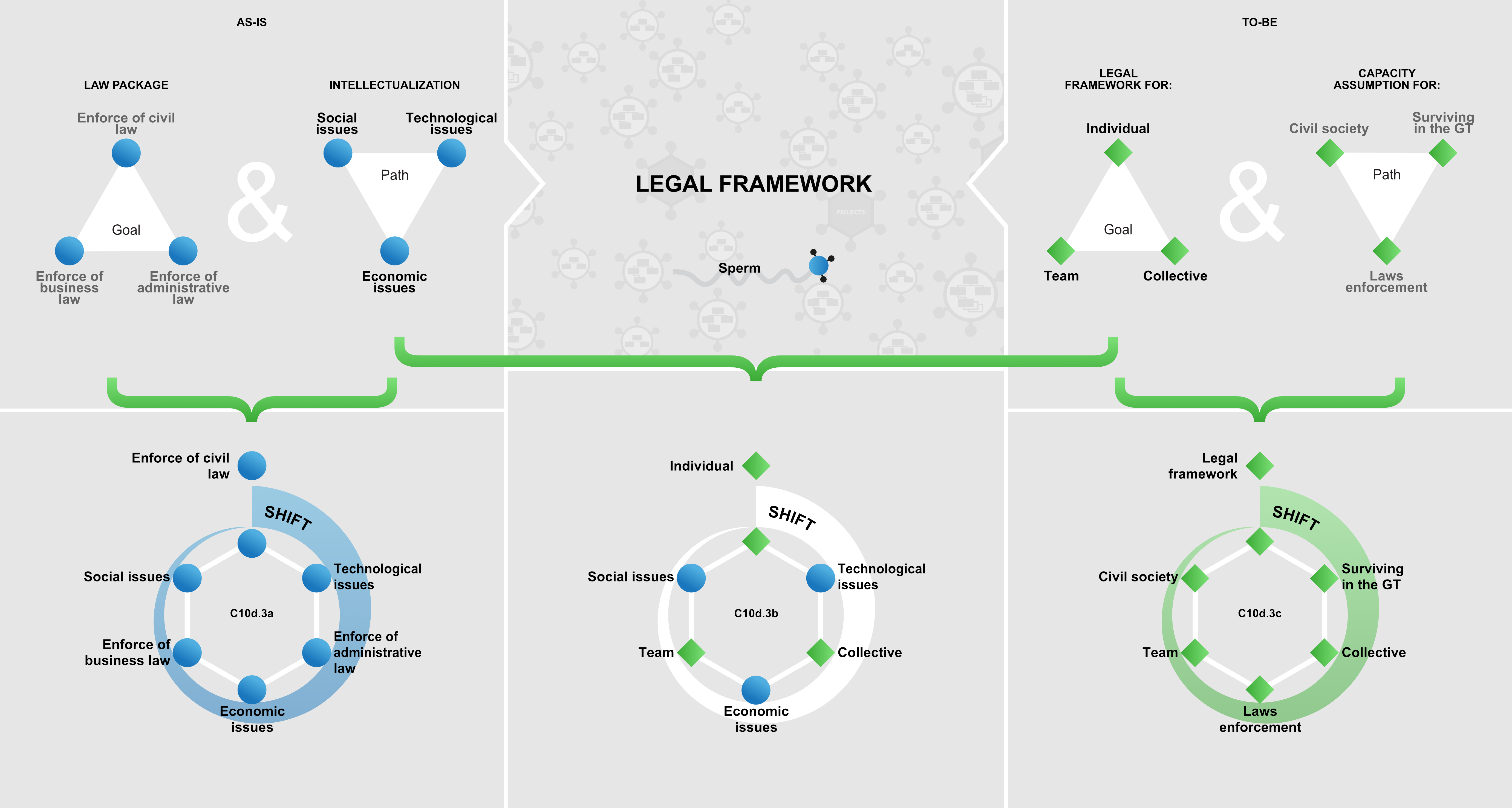Figure C10d.3 Legal Framework

Figure C10d.3 Legal Framework
Figure C10d.3 offers an approach to breaking down a "Legal Framework" object for scaling on a tactical level (for specific, open, and live cases).
The status As-Is has the potential to offer a realistic view on:
A set of laws, mainly on national levels, forms the Legal Framework with direct and indirect links to the lives of the Humans in the Great Triad (GT) environment (e.g., Civil, Business, or Administrative Laws).
The Legal Framework operates like a local and global influencer of activities of organizations and projects worldwide.
It is split into regional, national, and other levels and doesn't offer the needed self-integrity (e.g., more complex and rigorous transparency).
It doesn't strengthen exact law enforcement on time and with the necessary emphasis to support its (primarily local) authority (e.g., in the link to the international context), and
The paths of the Legal Framework services that cover three directions ( issues) of the business model in Figures C10a.2,3 are not still compatible with the trends of scaling and digitalization for the Global Digital Transformation (GDT) needs.
The model captures (remembers) the package of social, economic, and technological issues on the highest general level.
The status To-Be offers a realistic view on:
The content, forms, and enforceability of laws falling within the legal Framework (with a link to the business model in Figures C10a.2,3).
It has a direct link to environments with different preconditions for perceiving the sociological and psychological states of the behavior of individuals, teams, and teams for other territories and other time limits.
Finding a common denominator is difficult.
Concerning the needs of the Global Digital Transformation (GDT), the Legal Framework should be recognized as a need for scaling and digitization of Legal Framework that is tied to distributional trends of transformation (e.g., closer to Natural and Economic Laws) than to traditional national structures (e.g., closer to policy and national power).
The preconditions and the actual capacity of ways to find what we call civil society, to build the law enforcement in the Global Digital Transformation (GDT) environment from its empire stages.
Civil society (if it will be defined as an assignment of the GDT) is too long a path, and the gap between As-Is and To-Be is profound.
Indeed, the present "Climate Change" issues don't allow us to continue dreaming of the Human future (e.g., in the Space Wars style).
The present world will have to solve the survival and sustainability of the Human in the Great Triad (GT) more seriously (e.g., via more complex and trusted progressions presented and distributed by widely respected authorities, e.g., under the administrative jurisdiction of the UN).
The next step is to build the DDs for the Legal Framework to solve law performance issues and individuals' roles and find a good position for the Legal Framework in the Global Digital transformation (GDT).
The next step is to build the Dialectic Diagram (DD) for three situations:
For Civil Law Enforcement.
For the Individual's positions in the Legal Framework.
For steps of SHIFT in the Legal Framework.
1. The DD for the Law Enforcement:
The DD for the Law Enforcement we can read this way: the law enforcement has close to the social issues in situ (e.g., if there is no plaintiff, there is nothing to solve legally) and on the state level (e.g., the less democracy, the more they need for the potential of legal restrictions to grow).
For example, in a democracy, the development of Liberal Business Laws impacts local levels, generates the power for positive changes, and contributes to solving global economic issues.
It creates a positive motivation and opens the door for growth quality and enforcement of administrative laws.
The new environment can potentially change repressed technological issues into local and global progress (e.g., penetration of ICT components into low-income territories and provinces).
It supports building the practical (readable) Legal Frameworks in situ (e.g., in provinces) for a specific circle of actual issues (for more, see Chapter E, the SPC Drivers).
2. The DD for individual's roles in Competitiveness:
To identify and appreciate a share of each person's contribution to the Project (at least the best of them) needs a specific attitude. There are excellent examples, practices, which we call a sport.
Sport creates natural know-how for both a team's building and team management. Anycase, the triad "Capacity assumption" defines Competitiveness via three specific items: sport, war, and fear categories are significant (for the To-Be stage).
Sports and Wars are strong influences on the individual personality. Fear is a solid navigator for reacting to the Human's needs to survive (in the Great Triad environment).
It is a challenge for which sociologists and psychologists work.
3. The DD for the role of sociology and psychology influencers in development:
"Competitiveness must respect the individual personality base," this rule is a necessary condition for building teams, mainly for the tactical and operational levels.
It is a challenge of two dimensions: the first means a more profound involvement of the internet, and the second is more substantial involvement of experts in sociology and psychology in international cooperation (e.g., in the scope of tasks presented by this webbook).
For example, the voting system influences many soft (fuzzy) factors (from autocracy to democracy).
Then the decision-making processes have an extended response (with almost no potency) to specific (crucial) details of a particular project.
It causes trouble for most technological tasks (their transformation or dissemination). It is what we can see in the present world.
Plenty of Summits are running, and almost no progress we do not see on the climate change issues. The Human is not fighting enough for his/her sustainable position in the Great Triad (GT).